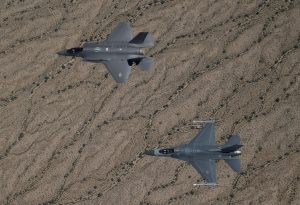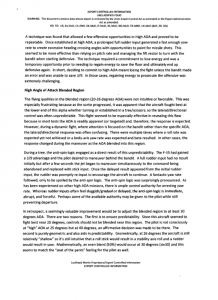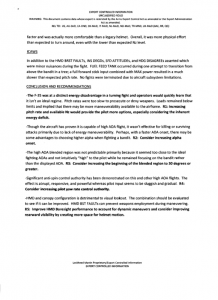
Beberapa waktu lalu dilakukan pengujian dogfight antara F-35 melawan F-16. Hasil pengujian menunjukkan kemampuan dogfight F-35 tidak sebaik F-16. Berikut ini dokumen lengkapnya.
Teks Dokumen
EXPORT CONTROLLED INFORMATION UNCLASSIFIED FOUO
WARNING: This document contains data whose export is restricted by the Arms Export Control Act as amended or the Export Administration
Act as amended.
REL TO: US, AU-DoD, CA-DND, DK-MoD, IT-MoD. NL-MoD, NO-MoD, TR-MND, UK-MoD (BAE, RR, QQ)
F-35A High Angle of Attack Operational Maneuvers 14 January 2015
Test Pilot:
Test Conductor:
Test Director:
Test Aircraft: AF-2, Test 715, Flight 505, Configuration 10-0016 (Clean Wing), 0.1-vl2.006 (R33.1)
OBJECTIVE
The test was designed to stress the high AoA control laws during operationally representative maneuvers utilizing elevated AoAs and aggressive stick/pedal inputs. The evaluation focused on the overall effectiveness of the aircraft in performing various specified maneuvers in a dynamic environment. This consisted of traditional Basic Fighter Maneuvers in offensive, defensive, and neutral setups at altitudes ranging from 10,000 to 30,000 feet MSI.. The Flying Qualities criteria were that the aircraft response would be positive and predictable and that there should be no undesired, unexpected, or unpredictable aircraft responses. Qualitative observations were made regarding the high AoA capability, cues that the aircraft was entering a low energy state, as well as various human factors considerations.
TEST ARTICLES
AF-2 was flown with empty weapon bays and clean wings in R33.1.5 software. Of note, there were no CATM weapons and no mission systems available for this test. No FTAs were utilized to open or close weapon bay doors to simulate weapon launch. An on-axis HMD fixed reticle was used to help assist in evaluating capture and tracking tasks but no symbology filters were available. The target aircraft was an F-16D Block 40. It was equipped with a GE-100 engine and configured with no CATM weapons and two 370 gallon wing tanks. No restrictions were placed on the target other than the basic aircraft design limits associated with wing tanks (7.0 Nz acceleration until empty).
MISSION EXECUTION
The sortie consisted of standard administration to the Sea Test Range. Ranging exercises were conducted to familiarize the target aircraft with F-35 visual cues. An offensive capture/tracking task was completed by the F-35 from 6,000 feet slant range with a 3,000 foot vertical offset at 22,000′ MSL and 400 kts. All other testing consisted of traditional BFM setups starting at 22,000′ MSL and 440 kts for 6K and 9K fights and 20,000′ MSL at 380 kts for 3K fights. The neutral fights began at approximately 18,000′ to 20,000′ with no limitations on airspeed or altitude following the check away. The floor was 10,000′ MSL. In all, there were seventeen engagements. No loads or other aircraft limits were exceeded with unrestricted throttle, stick, and rudder inputs.
OBSERVATIONS
Numerous observations were made that are not mentioned below. They are perceived to be of less significance or they are of higher classification. It is recommended that more pilots conduct this test since it is extremely effective at providing data that are not achievable with scripted test cards.
Energy Maneuverability
Overall, the most noticeable characteristic of the F-35A in a visual engagement was its lack of energy maneuverability. The test pilot had 2,000 hours of flight time in the F-15E, experience in F-16 Blks 30/40/42/50, exposure to flying the F-18F in high AoA, and has fought dissimilar BFM engagements with each in addition to F-15C. The EM of the F-35A is substantially inferior to the F-15E with PW-229s due to a smaller wing, similar weight, and ~15,000 lbs less in afterburner thrust. So, in general, the high AoA capabilities of the jet could not be used in an effective way without significantly reducing follow-on maneuvering potential. Even with the limited F-16 target configuration, the F-35A remained at a distinct energy disadvantage for every engagement
Pitch Rate
Insufficient pitch rate exacerbated the lack of EM. Energy deficit to the bandit would increase over time. Therefore, there were multiple occasions where it would have been tactically sound to accept excessive energy loss in order to achieve a fleeting WEZ. The CLAW prevented such shot opportunities (and hindered defeating shots). This included high energy conditions such as immediately off the perch. The average Nz achieved during the breaks or turn circle entries were typically “6.5 or less despite a rapid full aft stick pull and then decreased as energy depleted and the aircraft slowed on the limiter. Insufficient pitch rate also occurred at slower speeds such as during gun attempts. Instead of catching the bandit off guard by rapidly pull aft to achieve lead, the nose rate was slow, allowing him to easily time Ns jink prior to a gun solution. From a guns defensive perspective, the lack of nose rate (or alpha rate) also prevented creating closure because the bandit could react to the gradual onset even when near the front of the control zone.
High Angle of Attack
Due to the energy and pitch rate limitations described above, there were not compelling reasons to fight in this region Some cues that the aircraft was entering high AOA included a bleed through buffet back to a smooth jet, diminished wind rush over the canopy, and full aft stick with no pitch rate The leading edge flaps were noticed as an additional visual cue when looking across the circle or aft of 3/9. They don’t seem to be as pronounced in the F-16 but due to a much larger size in the F-15A, they were easily perceived while fighting the bandit.
A technique was found that allowed a few offensive opportunities in High AOA and proved to be repeatable. Once established at high AOA, a prolonged full rudder input generated a fast enough yaw rate to create excessive heading crossing angles with opportunities to point for missile shots. This seemed to be more effective than relying on pitch rate and managing the lift vector to turn with the bandit when starting defensive. The technique required a commitment to lose energy and was a temporary opportunity prior to needing to regain energy to save the floor and ultimately end up defensive again. In short, deciding to commit to high AOA meant losing the fight unless the bandit made an error and was unable to save 3/9. in those cases, regaining energy to prosecute the offensive was extremely challenging.
High Angle of Attack Blended Region
The flying qualities in the blended region (20-26 degrees AOA) were not intuitive or favorable. This was especially frustrating because as the sortie progressed, it was apparent that the aircraft fought best at the lower end of this alpha whether turning or established in a tree/sclssors; so the laterai/directional control was often unpredictable. This flight seemed to be especially effective in revealing this flaw because in most tests the AOA is readily apparent (or targeted) and, therefore, the response is expected. However, during a dynamic fight, where attention is focused on the bandit rather than the specific AOA, the laterai/directional response was often confusing There were multiple times where a roll rate was expected yet not achieved or a body-axis yaw rate was expected and beta resulted. In other cases, the response changed during the maneuver as the AOA blended into this region.
During a tree, the anti-spin logic engaged as a direct result of this unpredictability. The F-35 had gained a 3/9 advantage and the pilot desired to maneuver behind the bandit. A full rudder input had no result initially but after a few seconds the jet began to maneuver simultaneously to the command being abandoned and replaced with stick input. Once the delayed result appeared from the initial rudder input, the rudder was promptly re-input to encourage the aircraft to continue. A fantastic yaw rate followed, only to be spoiled by the anti spin logic. The anti-spin logic was surprisingly pronounced. As has been experienced on other high AOA missions, there is ample control authority for arresting yaw rate. Whereas rudder inputs often feel sluggish/gradual or delayed, the anti spin logic is Immediate, abrupt, and forceful. Perhaps some of the available authority may be given to the pilot while still preventing departure.
in retrospect, a seemingly valuable improvement would be to adjust the blended region to at least 30 degrees AOA. There are two reasons. The first is to ensure predictability. Since this aircraft seemed to fight best near 20 degrees, controls should not be Wended near this region. The pilot is not consciously at “high” AOA at 25 degrees but at 40 degrees, an affirmative decision was made to be there. The second is purely geometric and also aids in predictability. Geometrically, at 26 degrees the aircraft is still relatively ‘shallow” so it’s still intuitive that a roll stick would result in a stability axis roll and a rudder would result in yaw. Mathematically, an even Wend (50%) would occur at 30 degrees (sin30) and this seems to match the ‘seat of the pants” feeling for the pilot as well.
Guns Defense
No effective guns defense was found during this test. Various techniques were tried depending on aspect, energy, and closure. Attempts were made to maintain closure by staying in the 20-ish alpha region with lift vector on, while use rudder to get out of plane. Results were unpredictable as discussed above. For unloaded roll pull jinks, the slow pitch rate was evident in both the unload and the pull The result was a gradual out of plane maneuver which was easy to track. For floor and slow speed jinks, the high AOA control was adequate but there was no effective motion from the aircraft. The result was a target that was changing shape/attitude but not actually moving out of the pipper. Higher alpha usually just resulted in a larger planform target.
Buffet & Transonic Rolloff (TRO)
Despite concerns early in the program regarding buffet, it was not found to be detrimental during this mission. It was actually favorable when encountered because it provided a great cue of energy, similar to the F-1S. Buffet was never encountered with the bandit on axis and off-axis symbology was steady regardless of buffet level. The jet was below buffet energy levels when gunning the bandit and the aircraft was unloaded when shooting the bandit on-axis with missiles, ie across the circle. (The same pilot conducted the HMD readability tests for buffet conditions) A more difficult problem is ensuring gun pipper accuracy, especially considering the new ‘swimming’ filters but that was beyond the scope of this test (no filters were available on the FS aircraft). TRO was never encountered during the BFM engagements.
Rearward Visibility
The helmet was too large for the space inside the canopy to adequately see behind the aircraft. There were muftiple occasions when the bandit would’ve been visible (not blocked by the seat) but the helmet prevented getting in a position to see him (behind the high side of the seat, around the inside of the seat, or high near the lift vector). There were also several other times where the seat blocked the view. When the bandit was high, the ‘eyebrow* from the helmet often blocked the tally too. Whenever the helmet was pinned against the canopy, the pilot continued to strive to turn his neck resulting in the symbology no longer being in front of the eyes Multiple HMD BST FAULTS asserted during all of the motions, which may have been specific to the FS aircraft but plausible that it would occur in the MS jets too Beyond being a nuisance, it would further restrict weapons employment by either minimizing pilot movement or causing symbology to disappear
In general, It took a lot of physical effort to turn around for the visual. The pilot pushed fairly hard off the seat’s leg guards with the outer thighs to twist at the waist and also used a hand on the canopy often during left turns too The engine IPT noted that when this occurred, the much needed power often inadvertently decreased (with friction set at 6 o’clock) and it would’ve delayed activating CMD. In addition to the waist strain, tilting the head back and looking up turned the HVI cable into a sprite, further increasing neck tension; it was not uncomfortable but noticeable. The HMD weight was no factor and was actually more comfortable than a legacy helmet. Overall, it was more physical effort than expected to turn around, even with the lower than expected Nz level.
ICAWS
In addition to the HMD BRST FAULTS, INS DEGOs, SFD ATTITUDES, and HOG DISAGREES asserted which were minor nuisances during the fight, FUEL FEED TANK occurred during one attempt to transition from above the bandit in a tree; a full forward stick input combined with MAX power resulted in a much slower than expected pitch rate. No fights were terminated due to aircraft subsystem limitations.
CONCLUSION AND RECOMMENDATIONS
- The F-3S was at a distinct energy disadvantage in a turning fight and operators would quickly learn that it isn’t an ideal regime. Pitch rates were too slow to prosecute or deny weapons. Loads remained below limits and implied that there may be more maneuverability available to the airframe. Rl: increasing pitch rate and available Nz would provide the pilot more options, especially considering the inherent energy deficit
- Though the aircraft has proven it is capable of high AOA flight, it wasn’t effective for killing or surviving attacks primarily due to lack of energy maneuverability. Perhaps, with a faster AOA onset, there may be some advantages to choosing higher alpha when fighting a bandit. R2: Consider increasing alpha onset.
- The high AOA blended region was not predictable primarily because it seemed too close to the ideal fighting AOAs and not intuitively ‘high’ to the pilot while he remained focusing on the bandit rather than the displayed AOA. R3: Consider increasing the beginning of the blended region to 30 degrees or greater.
- Significant anti spin control authority has been demonstrated on this and other high AOA flights. The effect is abrupt, responsive, and powerful whereas pilot input seems to be sluggish and gradual. R4: Consider increasing pilot yaw rate control authority.
- HMD and canopy configuration is detrimental to visual lookout. The combination should be evaluated to see if it can be improved. HMD BST FAULTS can prevent weapons employment during maneuvering. R5: Improve HMD Bo resight performance to account for dynamic maneuvers and consider Improving rearward visibility by creating more space for helmet motion.
Berikut ini Hasil Scan Dokumen





Sumber:
